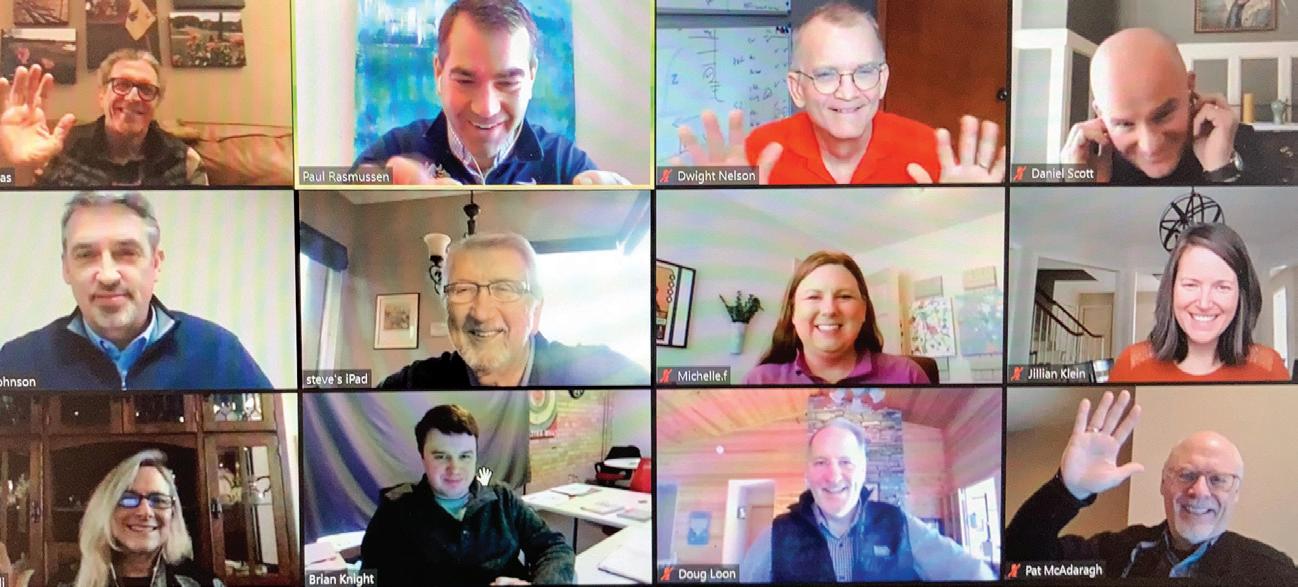
16 minute read
CREATING CONNECTIONS: Twin Cities Business Advisory Network Provides Support to Augustana Students, Alumni
CREATING CONNECTIONS:
TWIN CITIES BUSINESS ADVISORY NETWORK PROVIDES SUPPORT TO AUGUSTANA STUDENTS, ALUMNI
| BY JILL WILSON
One-fourth of all undergraduate students at Augustana come from Minnesota. The land of 10,000 lakes ranks second only to South Dakota for best recruiting grounds for the university.
While more than half of recent AU graduates reported working in South Dakota, many headed to Minnesota, too — for employment or to continue their education. In 2020, graduates found meaningful employment in places such as the Area Special Education Cooperative (ASEC), University of Minnesota Masonic Children’s Hospital, Loveworks Academy for Visual and Performance Art, as well as YWCA Minneapolis, Twin Cities Orthopedics and the Mayo Clinic.
In 2019, the university recognized the need to better connect with alumni and friends of Augustana in the Twin Cities. The university hired a director to build a strong Augustana network in Minnesota. That’s when the Twin Cities Business Advisory Network (BAN) was born.
“With more than 4,000 alumni residing in the metro area, the Twin Cities is home to the second largest concentration of Augustana alumni outside of Sioux Falls,” said Paul Rasmussen ‘03, director of development for the Twin Cities area. “We realized that we had this tremendous cohort of business leaders who were eager to explore opportunities to better connect Augustana to this market. That was the primary reason behind the development of the Business Advisory Network, and it’s only grown from there.”
The initial goal of the Twin Cities BAN was to have 8-10 members; a year later, the network has grown to 16.
Rasmussen, whose wife, mother and brother also went to Augustana, said, “Our alumni base in the Twin Cities is a real asset to Augustana and a rich representation of the liberal arts education. We’ve got alumni here leading America’s largest corporations, directing world-class education, health care and nonprofit organizations, as well as serving in senior government positions, guiding faith communities, launching startups, teaching the next generation of leaders and the list goes on.
“While alumni are active in all sectors in the Twin Cities, our common bond is our shared experience at Augustana and the lifelong relationships that we established there. That is the fun part of my work — connecting folks to Augustana and inviting them to be involved in building the university’s future.”
Three of the Twin Cities BAN members are also on Augustana’s Board of Trustees, and all but two members are alumni. The depth of knowledge is immense, but there’s also fresh perspectives; members’ graduation years vary from the Class of 1965 to the Class of 2012.
“It’s wonderful to have alumni and friends here that are extremely excited about the growth plans for Augustana through the Viking Bold plan,” said Rasmussen, who settled into the Twin Cities in 2011. “They are providing Augustana with feedback and insights from this market. They also want to connect students and faculty with research, consulting and experiential opportunities in the Twin Cities, Rochester and beyond.”
THE DEPTH OF KNOWLEDGE
Lois Martin ‘85, a native of Dell Rapids, South Dakota, now lives in St. Paul, Minnesota. She believes so many Minnesotans flock to Augustana because “it’s far enough away for school, but it’s also not so far where you can get back when you want to or need to.”
“It’s still a great Midwestern culture between the two, which I think a lot of people look for, but there are different career opportunities in the city,” said Martin.
The Chief Financial Officer (CFO) of Mortenson Construction says it helps to have a physical presence in the state she now calls home.
“It provides a group of phenomenal talent to Twin Cities employers,” said Martin. “And, I think that’s where the business network comes in. It is helping to make the university more known and more visible, both from a recruiting source, but also be a funnel of new recruits for Augustana.”
Martin says the Twin Cities BAN is also helping members connect with other members, opening up resources for everyone.
“Networking is just so powerful from a self-development standpoint.” The former Augustana Board of Trustee member of 12 years said, “We all run into different challenges personally and professionally. It’s wonderful if you’ve got a network you can tap into. We all have a common bond back to Augie, but it’s a diverse enough group in the network that it provides each of us access and contact points for different challenges we may run into. To me, our objective is to connect with all Augie grads and open up employers’ understanding here of what a great resource Augustana is.”
TWIN CITIES BUSINESS ADVISORY NETWORK MEMBERS
PAUL RASMUSSEN ‘03 Director of Development, Twin Cities, Augustana University
JODI DEHLI Owner and CEO, Dehli Development, LLC
MICHELLE FIELDS ‘99 Chief Marketing Officer, Burwell Enterprises PAUL LIMBURG, M.D. ‘87 CEO, Lawrence Leasing
DOUG LOON ‘86 President, Minnesota Chamber of Commerce
LOIS MARTIN ‘85 THE FRESH PERSPECTIVE LISA FLANARY ‘84 CFO, Mortenson
Twin Cities BAN member Jillian Klein ‘03 is now the senior SVP and Chief Growth Construction vice president of government and regulatory affairs at Strategic Officer, Thrivent PAT McADARAGH ‘81 Education, Inc., but says she didn’t always know where she wanted FRED JOHNSON ‘84 President and CEO, to land in her career. Senior Portfolio Manager, Midco Communications “I have such great feelings about my college experience,” said Klein, who studied business and religion as an undergraduate at Church and Institutional Lending, Thrivent DWIGHT NELSON ‘83 Principal, Neureux, LLC Augustana. “I felt really lucky to be in a community, especially as a JILLIAN KLEIN ‘01 student who came in not knowing at all what I wanted to do, that allowed me to explore the million different passions that I had as I SVP of Government and Regulatory Affairs, Strategic Education, Inc. JIM ODLAND ‘77 VP and Managing Counsel, Thrivent worked my way towards graduation. I had such a great experience with a liberal arts education that supported me as I’ve moved BRIAN KNIGHT ‘12 MARK RUNKEL ‘99 through my career. It equipped me with the knowledge I needed President, Bullseye Media, LLC EVP and Chief Credit Officer, US Bancorp to be able to learn how to learn and to say yes to opportunities that came my way even if they felt outside the realm of what my current KELSEY KNIGHT ‘11 DANIEL SCOTT ‘87 area of responsibility was.” That’s why the Eden Prairie, Minnesota, resident says she has a Partner and Director of Communications, Bullseye Media, LLC Attorney and Partner, Stinson LLP “heart for making sure, especially as young alums are moving to JOHN THOMAS Minnesota, that we’re supporting them in the ways they need to be supported as they start their own career journeys.” MIKE KNIGHT ‘82 Founder and President, Alliance Management Retired President and CEO, Arizant Healthcare
“When higher education is being questioned in terms of its value to students more than ever,” Klein says it’s important to ensure that the “Augustana education stays relevant and continues to be a great credential for students leaving the university in pursuit of their careers.” She says the investment Augustana is making in the Twin Cities is immense.
Klein noted, “It’s obvious Augustana is taking seriously its commitment to ensuring that it’s setting students up to be successful in the best way possible.”
Meeting three times a year, the group has heard from President Stephanie Herseth Sandlin on Augustana’s strategic plan, Viking Bold: The Journey to 2030, as well as Provost & Executive Vice President of Academic Affairs Dr. Colin Irvine about the creation of new university programs and the potential for more. The group is looking forward to upcoming presentations from Assistant Professor and Director of the MBA Program Dr. Anissa Goehring and CFO & Executive Vice President Shannan Nelson on campus improvement projects.
“We’ve just begun to scratch the surface of student and alumni opportunities in the Twin Cities in the past year. There’s a lot of work left to do. While COVID-19 has limited our in-person networking opportunities, it has accelerated our ability to connect with each other in new and innovative ways,” said Rasmussen. n

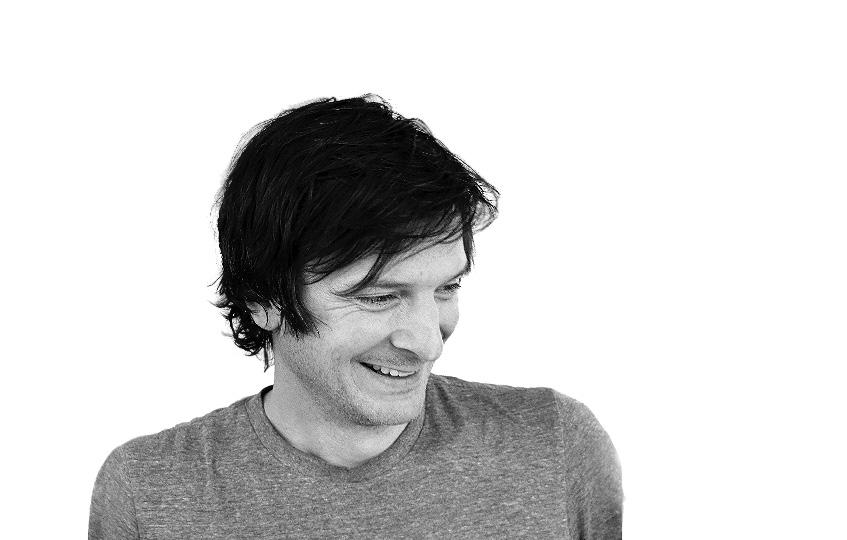
A CAREER BEYOND THE CUBICLE
| BY JOEL GACKLE
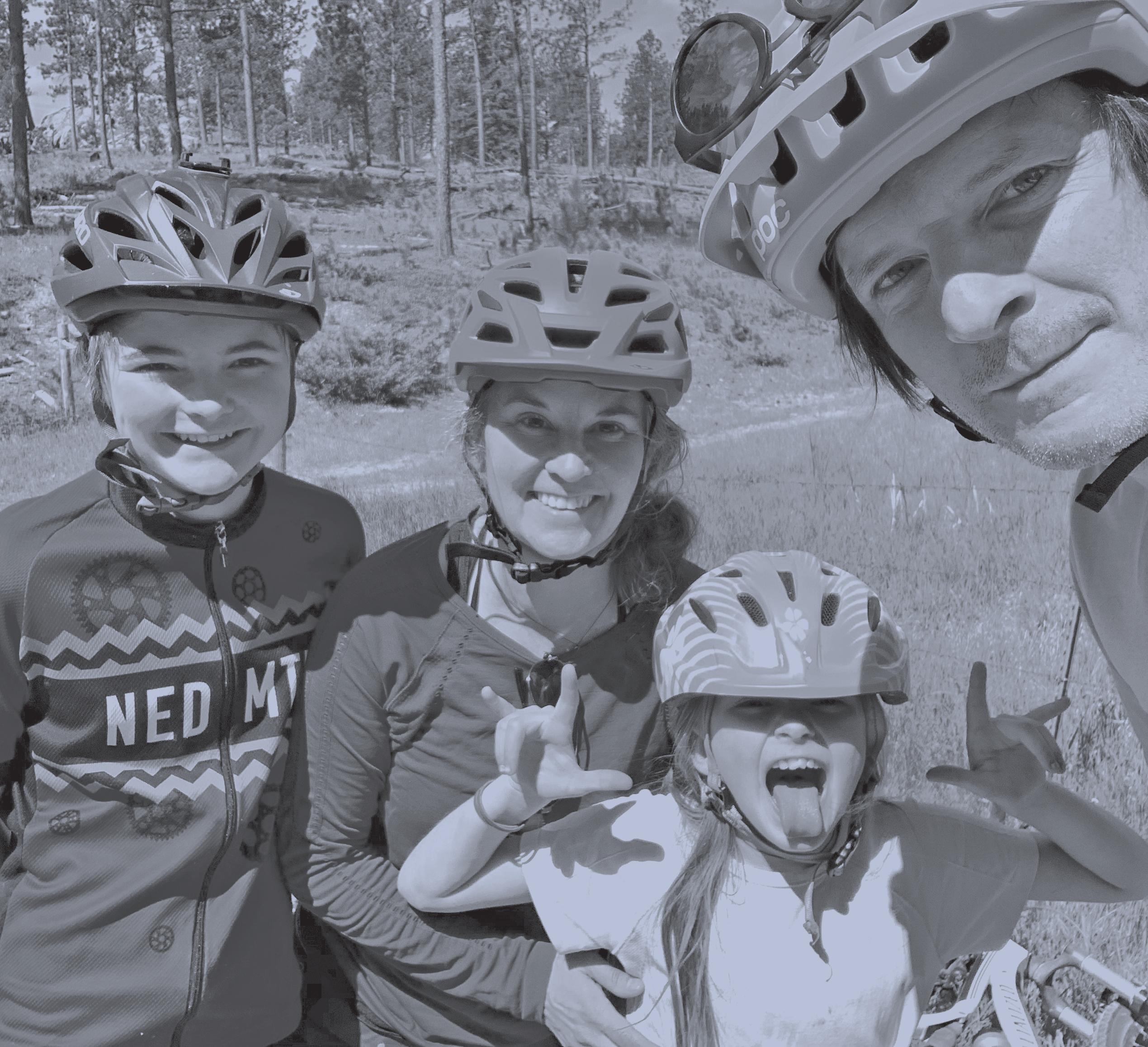
We are drawn to a place where we find the balance of energy and inspiration, a place where we feel most alive. Some are drawn to the frenetic hum of the city, of the energy provided by the sights and sounds of places that never rest. Others find freedom in the great outdoors, where spaces are defined by nature, and time is measured by the sun. The most fortunate are those who are able to align their ideal location with a career that feeds on their passions.
For Boulder, Colorado, businessman Robb Shurr ‘98, the place where he is most alive is the outdoors, and it has been a lifelong love affair. Growing up on the Mississippi River near St. Cloud, Minnesota, afforded Shurr opportunities to explore and discover.
“Racing, cross-country skiing and mountain biking (among many other activities) were a big part of my childhood,” said Shurr.
The outdoors not only ignited his sense of competition and adventure, it inspired his imagination and drive.
While the outdoors brought him energy, Shurr’s father knew an excellent college education would bring balance to his passions. The college professor told Shurr, and his sister, Sharla ‘93, they needed to attend a university grounded in the liberal arts. Augustana proved to be the ideal place to balance his inquisitive thinking with effective communication and his love of the outdoors. He credits his parents for refining his sense of purpose.
Shurr said, “My parents instilled a strong sense of conviction and a strong work ethic.”
He began on a pre-med track but was quickly drawn to business communications.
“It was such a great multi-disciplined major for me,” said Shurr.
After graduation, Shurr pursued a career in advertising, but then realized it didn’t align with his ideals or goals. He decided to pursue a graduate degree in communications, realizing effective storytelling was the only way to capture attention and sustain impact.
Following graduate school, he and his wife relocated to California where Shurr worked as a marketing director for two outdoor industry organizations, something he loved.
It also brought perks that couldn’t be matched. “We got to do board meetings in Yosemite.”
Shurr took a position with another outdoor industry organization in Boulder before he felt the need for a change. “I got the itch to start my own thing,” but the excitement of his first entrepreneurial endeavor quickly faded.
“I launched two days before the housing collapse in 2008,” said Shurr.
To add to the uncertainty, two of the founding partners decided to forgo building a company, and instead, chose the security of their larger employers.
Undeterred, Shurr’s first company was launched. It was a communications firm, specializing in strategy and insights for the outdoor industry. It helped brands build sustainability into their business plan. This chapter proved to be another time when his passions and his talents merged. He shared an office suite with two longtime professional climbing friends. Those friends went missing while on a climbing expedition in China.
“We launched an international rescue, and I ran all communications,” said Shurr.
Unfortunately, it was discovered that an avalanche had taken their lives. That loss set the foundation for another endeavor for Shurr. Shurr is now the CEO of Walden Hyde, a strategic creative agency focused on “helping clients make a difference in the world.” Walden Hyde was created a few years after his initial communications company.
Shurr works with what he calls “Constructive Brands, those brands that advance profitability without screwing over current or future generations.”
Shurr works with organizations ranging from multinational corporations to small businesses in understanding how their companies can look forward — focusing on how sustainability and values will impact their future business and customers.
Perhaps the days of childhood exploration and discovery brought other benefits to him. With two companies under his belt, Shurr realized he is most alive when he is taking calculated risks.
He added, “I don’t have that voice of fear that prevents me from trying something.”
The CEO has gone on to bootstrap two other companies, including one focused on helping school children deal with anxiety through mindfulness. When tragedy struck his friends in China, Shurr experienced crippling anxiety for the first time in his life. He sought professional help and quickly discovered freedom through mindfulness exercises. He wanted others to discover it as well.
Shurr’s experience as a founder and an entrepreneur has led to an ever expanding portfolio. His latest company is actually a start-up studio, partnering with investment backing to launch even more companies, with almost 20 currently in building stages. All of the success of the past decade is a result of his education, experience and grit.
Augustana helped form foundational relationships, clarity of purpose, and critical thinking that has helped Shurr forge a bold path. He credits Augustana with the most important decision of his life.
“The best thing about Augustana is I met my wife,” and it’s evident he means it. With the growth of his companies and the brands he has helped, he quickly lists his greatest success and source of pride: “We have a really great family.”
Whether living along the Mississippi River, working in Yosemite or exploring the Rockies, Shurr found that place that brings him life. He has also carved a career to make sure others can experience the same joy in the outdoors he holds dear. When it came down to a career or the outdoors, he married the two, and has been boldly moving forward, loving every step of the journey. n
- LUKE GROTH, ASSISTANT ATHLETIC DIRECTOR FOR INTERNAL OPERATIONS
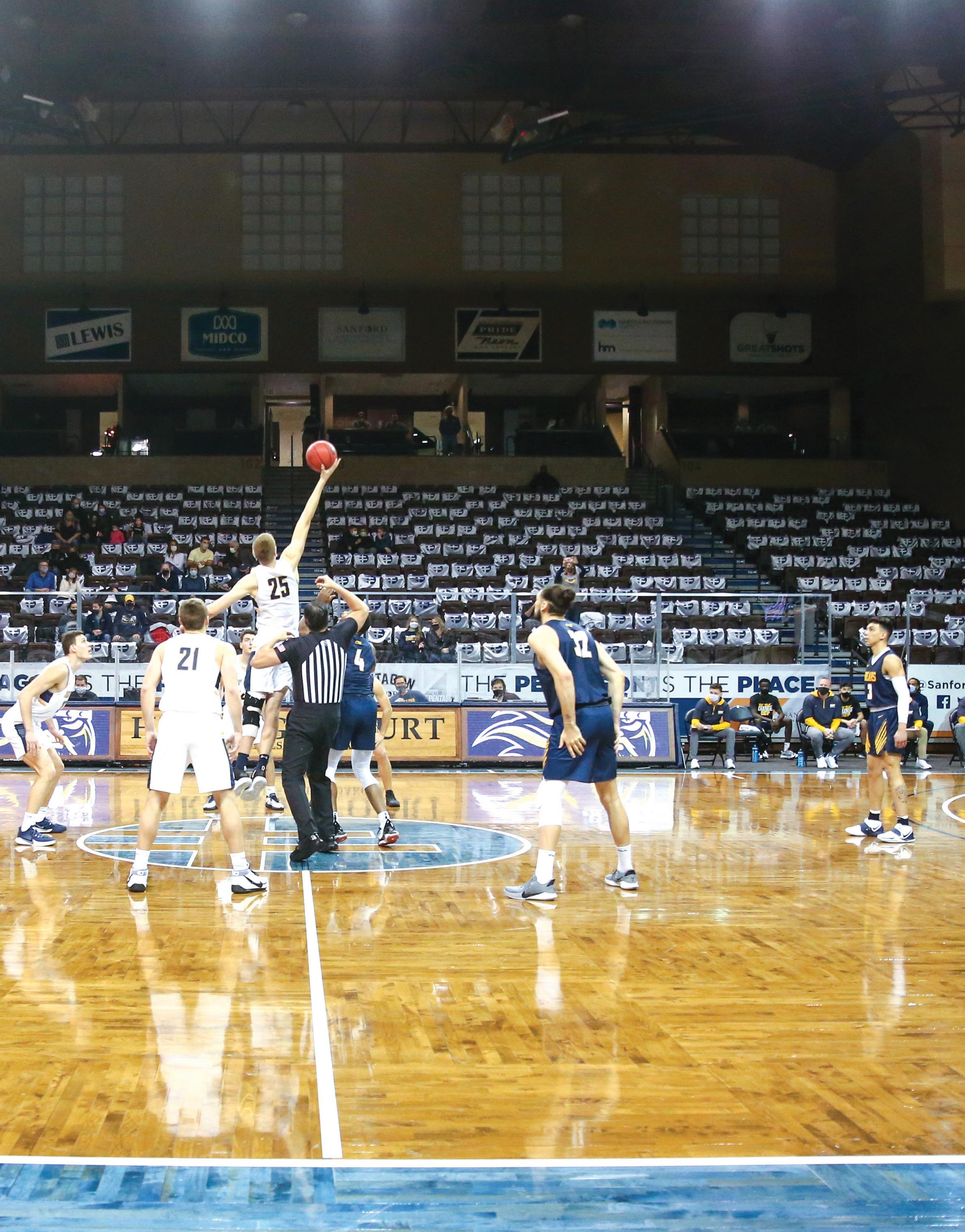
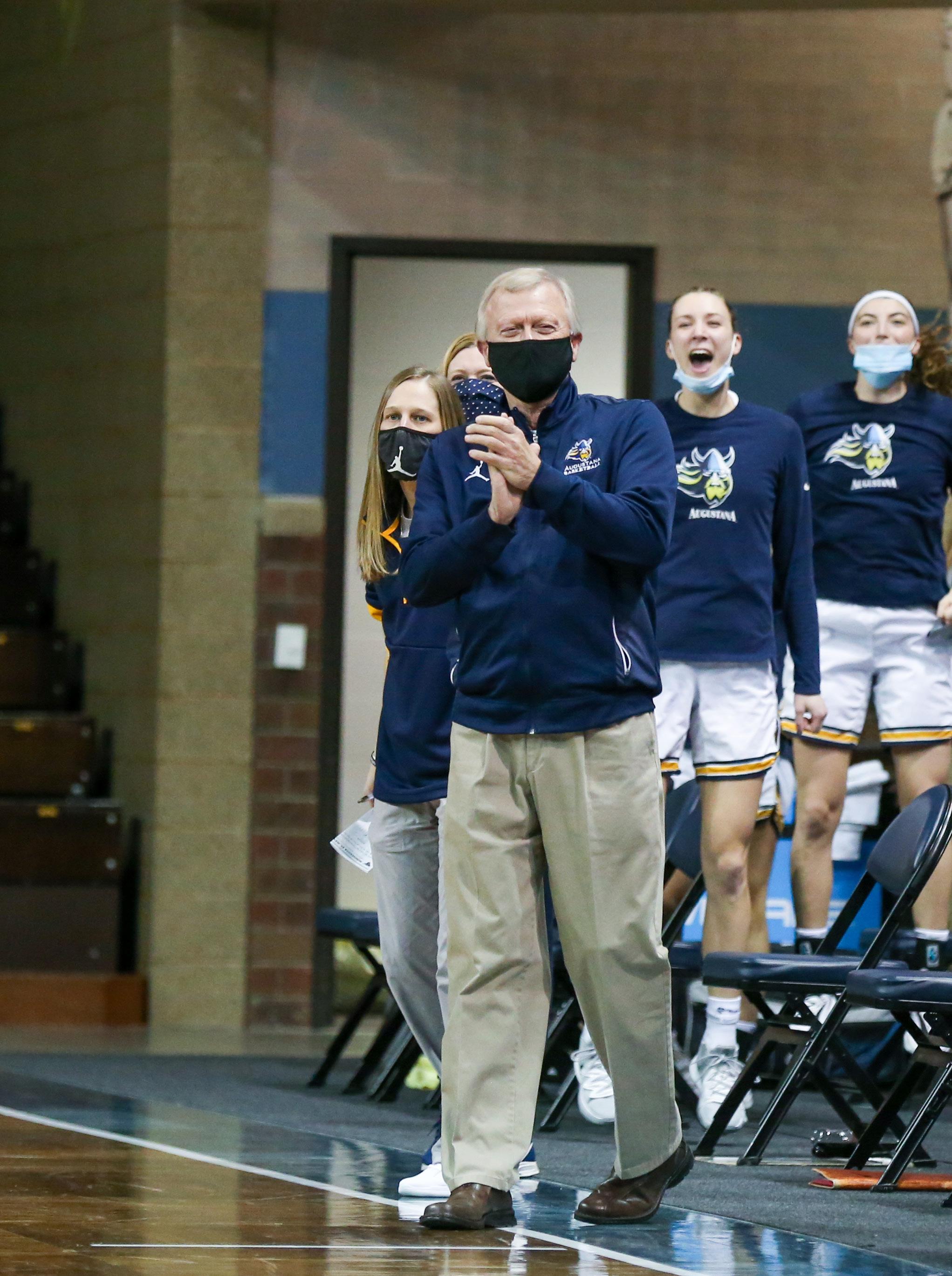
A SAFE RETURN TO SPORTS
| BY RYAN HILGEMANN
When the Northern Sun Intercollegiate Conference (NSIC) shut down sports in the spring of 2020, work immediately began on how to safely resume sports come fall and winter. As the COVID-19 pandemic pushed through the summer, the NSIC canceled its fall sports seasons and fully focused on starting winter sports the first weekend in January 2021.
At Augustana University, the focus remained on providing a championship experience while also determining how to best provide a safe environment in which to compete again.
“A lot of great teamwork and relying on experts helped us navigate through the process,” Director of Athletics Josh Morton said. “I learned early on in the pandemic that I’m not an epidemiologist, nor a doctor, and luckily, we have experts in health care as part of our team at Augustana.
“We leaned heavily on our head athletic trainer, Brian Gerry, and our team physician, Dr. Scott Boyens, to help put safety plans in place.”
Those plans paid off to help practices get underway in September, albeit, in non-traditional ways.
“We’d come in and scrimmage each other and it was weird getting used to wearing a mask while working out,” women’s basketball player Aislinn Duffy ‘23 said. “Hearing communication on the court is different. You have to be louder because you are wearing a mask.”
Although teams had to make changes to the way they were used to competing, they were willing to do whatever it took to play.
As the fall turned into winter, the NSIC revised its schedules several times, but the work was full steam ahead to make plans for competition.
“The hardest part has been a combination of making plans and then having to change and adapt to CDC, NCAA and NSIC recommendations, as well as the Sport Science Institute (SSI) guidelines,” Assistant Athletic Director for Internal Operations Luke Groth said. “There is no manual or playbook on how to go through a pandemic and almost no one has ever done it before. Our department has had to be flexible and learn as we go.”
Part of Groth’s position was to figure out how to test according to the NCAA SSI guidelines, which included securing nearly 3,000 COVID-19 tests to get through the school year. When practices initially started, testing was done once a week, and when games began, testing moved to three times a week for high-risk sports such as basketball and wrestling. But again, the Augustana administration has been willing to do what it takes to allow for the return to competition.
“Our student-athletes deserve it,” Morton said. “They deserve the opportunity to compete and it’s a big reason why they chose Augustana — competitive excellence.
“There’s no question that for all of us in the athletics department — coaches, administration, trainers and especially our athletes — competition is a key component to our well-being.”
All the work and effort paid off on January 2, when the men’s basketball team took to the court at Minnesota State University Moorhead (MSUM) — the first competition in the NSIC since the start of the pandemic. The Augustana women hosted MSUM later that same day at the Elmen Center, with only players, coaches and essential workers inside.
“One of the moms on our team actually made cutouts of our family to make it feel like we had people there supporting us,” Duffy said. “But it was still strange playing with no fans. The atmosphere is definitely different.”
On the second weekend of action at the Sanford Pentagon, Augustana made the decision to allow fans at games in a limited capacity.
“Our philosophy on spectators, even going back to fall scrimmages in football, was to slowly open things up if we can do it safely,” Morton added. “Our student-athletes deserved the chance for people to watch them.
“Specifically, at the Sanford Pentagon, we are blessed to call that our basketball home. It has been set up for safety since November with pod seating, traffic flow within the building and plexiglass separators throughout.”
Duffy immediately noticed a difference when playing in front of the limited crowd.
“You could just tell our energy completely shifted,” Duffy said. “We just knew we were lucky because a lot of the schools in the NSIC weren’t allowing fans.
“In that first game (in front of fans), you could tell our energy was up. You’d like to say you have total control of your own energy at all times, but you definitely feed off the environment you are in.”
Additional safety measures are in place for when teams travel. Coaches assign a seating chart on the bus to help with contact tracing, with your roommate seated closest to you. Roommates have also remained the same on every trip.
In the end, all the efforts put forward to have a season have been appreciated.
“There were a lot of ups and downs throughout the fall,” Duffy added. “There were times we were pretty pessimistic, but we all agreed we would work hard during preseason and if we get our season, we’ll be super grateful.
“Once we knew that we were for sure going to play at least a few games this year, it definitely made the five months of practice even more worth it.” n







